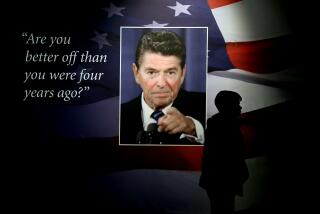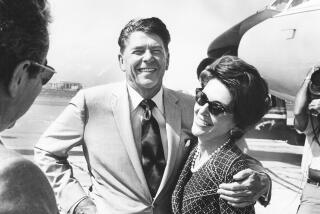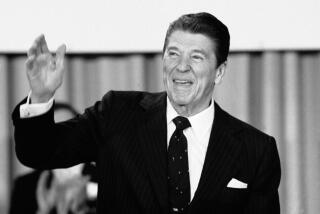Reagan Library, Museum Ready to Take Center Stage : Legacy: Complex near Simi Valley will be dedicated Monday and includes archives of the 40th President.
- Share via
SIMI VALLEY — The stage, sound and lighting were designed by Universal Studios and the offstage narration will be provided by the actor who once played Moses.
The overall choreography was arranged by a savvy political insider known for creating visual images. And if all of the players make the stage, the event will be a historic meeting of five presidents.
But the real star of this show, event planners say, is the Ronald Reagan Presidential Library, a mission-style building that holds the paper legacy of the Reagan presidency, as well as tons of memorabilia from his years in office.
At 153,000 square feet, with a $56.8-million price tag, it ranks as the largest and most expensive presidential library.
At Monday’s dedication ceremonies, former President Reagan will symbolically hand over the keys of his library to U.S. Archivist Don W. Wilson so that millions of pages of Reagan White House documents can be preserved for posterity.
As the presidential papers trickle out over the next generation, they will reveal the inner workings of the Reagan White House, offering scholars a rich source of material from an era of American history.
“A presidential library is a place where you can see history through the eyes of the President,” said Ralph C. Bledsoe, the library’s director. “This is not just a memorial to a former President; it is a place run by the government for the public to study history.”
To fans of Reagan, the massive complex perched on a hilltop near Simi Valley will serve as a fitting tribute to their beloved leader. To his critics, it will be seen as little more than a shrine to the nation’s first actor to become President.
“The popular notion is that the libraries are built as monuments to the egos of presidents,” said Richard Norton Smith, director of the Herbert Hoover Presidential Library. “That’s not true. They are built as monuments to the rich friends and White House staffs of presidents.”
Reagan aides, eager to make history on Monday, have labored to arrange for all five presidents to speak during the 1 1/2-hour ceremony, emceed by Charlton Heston. Gen. Colin L. Powell, chairman of the Joint Chiefs of Staff, will lead the Pledge of Allegiance, and country-Western singer Lee Greenwood will belt out “God Bless the U.S.A.”
President George Bush and former Presidents Reagan, Richard M. Nixon and Gerald R. Ford appear to be sure bets. Former President Jimmy Carter said he will try to attend if he can conclude his commitment to monitor the first democratic elections in Zambia.
Ceremony planners emphasize that Monday’s gala event is designed more as a celebration of the presidency than of Ronald Reagan. Joining the presidents on the dais will be surviving First Family members Lady Bird and Luci Baines Johnson Turpin, Caroline Kennedy Schlossberg and John F. Kennedy Jr., and descendants of Franklin D. Roosevelt.
But the dedication ceremonies also are designed to please the invitation-only audience of 4,200 former Reagan aides from Sacramento and Washington, political campaign staff members, financial backers and other admirers. The event was timed to be exactly 11 years from the day Reagan was first elected President.
Monday’s ceremonies will cap a weekend of parties planned for Reagan political alumni and the library’s financial backers. The names of contributors of $50,000 or more have been chiseled into the limestone wall in the library foyer. The complex will open to the public on Wednesday.
After months of planning, the foundation staff promises plenty of razzmatazz, financed by a budget of $500,000, not counting in-kind contributions from the federal government, various businesses and the largess of individual foundation board members.
Lew R. Wasserman, a board member and Reagan’s one-time movie agent, arranged for the ceremony’s stage, sound and lighting. As chairman of MCA, he also provided the 13 trams from MCA-owned Universal Studios theme park to ferry invited guests up the milelong Presidential Drive.
Foundation Chairman Lodwrick M. Cook, who is also the chief executive officer of Arco, put media wizard and former Reagan aide Michael K. Deaver on the Arco payroll for “in the ballpark” of $15,000 a month for six months to arrange the opening ceremonies.
Cook even provided Carter with one of Arco’s corporate jets to whisk him back to the United States as soon as he fulfills his commitment in Zambia. Without the jet, Carter said, he definitely could not make the ceremony.
When Reagan relinquishes the keys, the Reagan library will become the ninth presidential library in the National Archives system.
The Ronald Reagan Presidential Foundation has raised $57.2 million in private donations to build the library and its museum.
Foundation board members, most of them former aides and wealthy friends, hope to raise another $6.5 million and collect $11.3 million in pledges to pay off a construction loan, cover administrative costs and set up an endowment for a conservative think tank, to be called the Ronald Reagan Center for Public Affairs.
The foundation has retained control of about a fifth of the building for the public affairs center and a suite of offices for its staff, the former President and former First Lady.
The rest of the library complex will be turned over to the National Archives, including the 22,000-square-foot museum that was assembled by professional museum designers under the Reagans’ personal supervision.
Following the tradition of other presidential libraries, the Reagan museum was designed as more of a celebration of Reagan’s presidency than a dispassionate assessment of his two-term Administration.
“If you look at any of the presidential libraries, the exhibits tend to be portrayed from the President’s perspective,” said John T. Fawcett, assistant U.S. archivist in charge of the libraries.
The museum and gift shop will be the library’s main public attractions, drawing as many as 500,000 people a year, archivists say. After Reagan dies, the staff expects the Reagan burial site on the west patio to attract tourists too.
Using photographs, captions and half a dozen videos, the museum traces Reagan’s life from a small-town boy through his eight years as President. In addition to reviewing some of his policies, the exhibits reveal what it is like to live in the White House and includes a replica of the Oval Office.
The National Archives is far more concerned with the primary mission of the library: to preserve and ultimately make available its storehouse of official records.
Archivists have begun sifting through the 47 million pages of documents in the library’s basement and sub-basement, which represent the largest collection of presidential papers.
Within a few years, that number is expected to swell to more than 55 million pages after more key Reagan associates donate their personal papers and independent counsel Lawrence E. Walsh concludes his investigation of the Iran-Contra scandal and releases 1.5 million pages of related documents held in Washington.
At the direction of Reagan, archivists will open an estimated 6.3 million pages of documents to the public on Nov. 12--the largest initial release of documents at any presidential library. The documents will be available to scholars and curious citizens alike.
Nearly 5 million pages are unsolicited letters to Reagan, praising or condemning his decisions, commenting on world affairs or asking for a job. The others are routine position papers and factual information on such topics as agriculture, parks and monuments.
The vast majority of documents, perhaps as much as 90%, will remain shielded from public scrutiny until 2001 or beyond by a variety of restrictions to protect national security, foreign policy and confidentiality.
Documents classified as secret are kept in the walk-in national security vault embedded 30 feet into bedrock beneath the library’s ground floor. The most sensitive are in one of the vault’s six combination-lock safes, bolted to the concrete floor.
The basement also holds an estimated 75,000 gifts given to the Reagans during their eight years in the White House. The gifts range from jelly bean jars and folk artists’ portraits of the Reagans to a Cossack saddle from Soviet leader Mikhail S. Gorbachev. Only a few can be on display at any one time.
The library basement also has an audiovisual center that in December will receive 1.5 million photographs, 20,000 videotapes and miles of motion picture film. The public will be able to review the film and even order copies of stills.
Reagan is the last President who will be allowed to build a library privately and then expect the federal government to pay for its upkeep. In 1986, Congress grew concerned about the escalating size and cost of presidential libraries and passed a law requiring presidential foundations to set up endowments to help maintain them.
At the time, White House staff argued that the bill should not apply to the sitting President, and Congress agreed to exempt Reagan. Since then, a few Democratic senators have called on Reagan to comply voluntarily with the law.
Earlier this year, Reagan foundation officials and the National Archives signed a joint-use agreement that calls on the foundation to pick up its share of utilities for the 29,000 square feet of office space reserved for the public affairs center and other offices.
Taxpayers will pick up the rest of the cost, including maintenance of the grounds and security for the entire building. Such costs are expected to be about $1 million to $1.5 million a year, said National Archives spokeswoman Jill Brett.
Although Stanford University initially was the preferred location, the hilltop between Simi Valley and Thousand Oaks has worked out as an ideal setting for the Reagan library, his aides said.
Located halfway between the Reagan’s Bel-Air estate and Santa Barbara ranch, the conservative suburban communities have been far more receptive than hostile Stanford faculty members, who drove the Reagan foundation to look elsewhere.
Moreover, Reagan loves the rugged Western beauty of the terrain with its dramatic outcroppings of red rock, his aides say.
The area, which served as a backdrop to thousands of movie Westerns, will play host Monday to a star-studded event of a far different sort. “It is going to be a terrific event,” said foundation chairman Cook. “I just hope it doesn’t rain.” The foundation has 4,000 umbrellas standing by, just in case.
The Ronald Reagan Presidential Library
The Ronald Reagan Presidential Library opens to the public Wednesday. Besides housing Reagan’s presidential papers, the library’s museum will trace his life from boyhood to the presidency and feature a replica of the Oval Office. Here is a look at the building:
Building Facts
Site approved: November, 1987.
Groundbreaking: November, 1988.
Construction firm: C.L. Peck / Jones Brothers Construction, of Westwood.
Construction: June, 1989 through February, 1991.
Cost: $57 million for entire project.
Funded by: The Ronald Reagan Presidential Foundation with private donations.
Style: California Mission.
Construction materials: Red, California mission tile roof--more than 200,000 individual pieces used-- with beige stucco and plaster exterior; 805,000 lbs. of structural steel used.
Architect: The Stubbins Associates, Cambridge, Mass.
Building size: The library is 153,000 square feet; the museum inside the library is 22,000 square feet.
Site size: 38 acre-site on 100 acres of land donated by Los Angeles development firm Blakeley-Swartz.
Parking: 382 car, 49 recreational vehicle and 12 bus spaces.
Library workers: 22 .
Library Volunteers: 200.
A Guide to the Public Exhibition
1) Entry to Public Exhibition
2) Hall of Presidents Gallery--Large, metal cut-out signatures of every U.S. president, ranked in chronological order.
3) Waiting Area--For visitors waiting to see an orientation film. Contains four western-themed bronzes, and two murals: one of Reagan’s early life; one of his presidency.
4) Theaters-- Small auditoriums where the museum’s orientation film plays every 10 minutes.
5) Early Years Gallery-- Includes photographs and memorabilia of Reagan’s life through his Hollywood days. Also includes a model of the interior of his boyhood home in Dixon, Ill.
6) Road to Presidency Gallery-- Silk-screened images, artifacts and letters illustrate Reagan’s political life from his time in the Screen Actors Guild through his presidential campaigns.
7) World in 1980 Gallery-- Focuses on world and national events the year Reagan became president, including the war in Afghanistan, the hostage crisis, etc.
8) The Presidency: Prosperity Gallery-- Uses photographs, quotes and charts to show how Reagan’s policies impacted inflation, taxes and jobs. Video and photos depict the 1981 assassination attempt.
9) Head of State Gifts Pavilion-- Gifts given to Reagan during his eight-year term.
10) The Presidency: Peace and Freedom Gallery-- Two timelines: one on Reagan’s military policies, the other on his effort to encourage democracy around the world. Includes INF treaty documents.
11) Voices of Freedom Gallery-- Includes a metal wall etched with the names of dissidents and others freed from incarceration as a result of Reagan’s efforts. Display cases of related artifacts and memorabilia.
12) Legacy Video Theater-- A three-screen, multi-image, short video, regarding the history of Communism, from Stalin to the fall of the Berlin Wall.
13) Oval Office Replica -- A duplication of Reagan’s office in the White House.
14) Life in the White House Gallery -- Documents the Reagans’ time in the White House, with photos and memorabilia, as well as their time at Camp David and their California ranch.
15) First Lady’s Gallery-- Chronicles Nancy Reagan’s early life. Includes a collage of her career in Hollywood, with movie posters and newsclippings.
16) Interactive Video Theater-- Two dozen, two-to-three-minute films of Ronald Reagan speaking on various subjects. Visitor may choose a film using a touch-screen computer menu.
A Multilevel Structure:
Second floor: Offices/conference area for President and Nancy Reagan, offices of the Ronald Reagan Foundation. Not open to the public. See detail at right.
Ground floor: Public exhibition area, scholars’ research room. Offices of National Archives staff. See details at right.
Lower ground floor: Records and audio-visual storage, museum preparation and object storage. Not open to the public. Also houses The Ronald Reagan Center for Public Affairs, a conservative think tank run by The Reagan Presidential Foundation. Not open to the public.
Basement: Records storage. Not open to the public.
Museum Hours:
Monday-Saturday: 10 a.m.-5 p.m.
Sunday: Noon-5 p.m.
Admission: $2 for the public, $1 for senior citizens. Children 15 and under admitted free
More to Read
The biggest entertainment stories
Get our big stories about Hollywood, film, television, music, arts, culture and more right in your inbox as soon as they publish.
You may occasionally receive promotional content from the Los Angeles Times.










